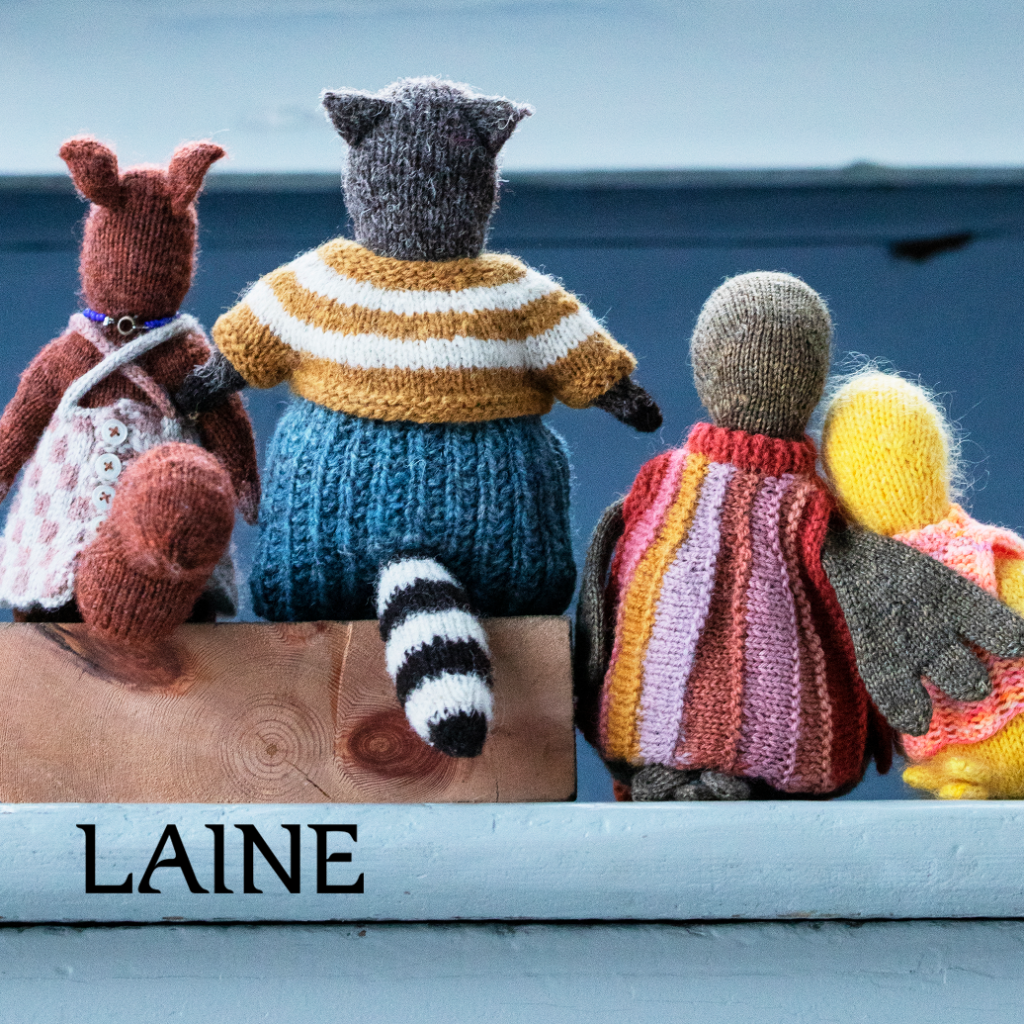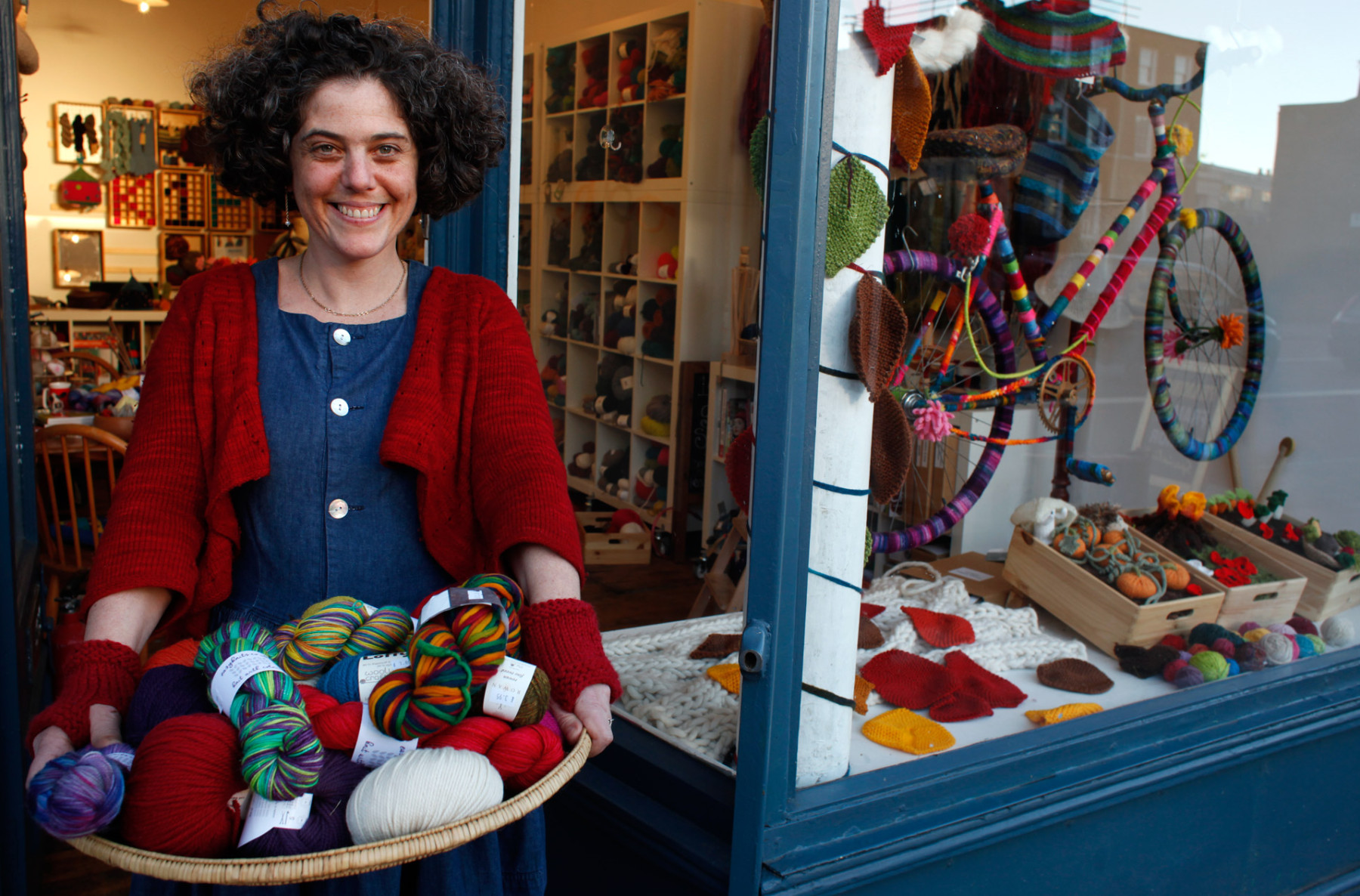‘This pattern should be impossibly frustrating,’ I wrote of a pattern I was knitting back in early 2020, ‘and yet it’s the most delightfully compulsive knitting… the littleness of the stitches and Odile’s diminutive form are just so inexplicably pleasing.’

The pattern was Bunny Odile, and making it marked the beginning of one of the most enchanting and kooky knitting paths, this shop has ever taken. It was also the start of a friendship with the designer who seemed immediately at home in the shop without ever being able to visit it. The bunny was soon joined by Borscht Bear (cousin of Myrtil), and later that year a troupe of sassily-dressed mice (AKA Sadie Souris and her friends), who briefly occupied a whole purpose-built house in the shop window.
‘I look closely at animals,’ explains Cinthia Vallet, the toy maker behind this curious menagerie of animals which has been slowly growing since she first began writing knitting patterns in 2018.
‘I try to observe animals to translate into words what I think this animal is supposed to be. So for example the Lady Duck – it’s all about the curve of a very bald head. It’s also about the neck which is curved like this.‘
Cinthia lifts her hands to show me the curve.
Cinthia lives in Nantes in France and I’ve arranged a Zoom meeting so we can talk more about the animals and her new book, Mouche and Friends, which was published last Friday.
In preparation for our chat and a new window display to celebrate the book, I’d spent the previous 10 days knitting Nanna, the Lady Duck and 3 ducklings: Dodo, Mimosa, and a 3rd rogue cousin from Clapton called Norman, so I’m already familiar with this curve that she’s explaining.
Each of the ducks begins with an intriguingly simple yarn-wrapping cast-on. This so-called Turkish cast-on creates a ‘spine’ around which you knit circularly straight away, so there is no opening to sew up. Using 2mm needles, my stitches start forming the fabric of a protuding beak and then the surrounding upper and lower parts of a curved head. This combination of an extraordinarily tight gauge and an intricate series of 3 sets of differently sequenced short-row segments, has turned my knitting into a form of stitchy sculpture. Within an hour, the duck has form, features and somehow also character. Meanwhile my hands and my own inner dialogue with my knitting, have settled into a new friendship with the lines of the pattern.

Periodcially the pattern calls for rearranging stitches around a new beginning-of-round starting point. This is a somewhat fiddly operation on the skinny bendy needles I’m using. But in a manner that begins to feel habitual, the next round is always given as a simple, knit-the-round-once instruction, as if it knows you need a quiet round to settle in and reorientate yourself to the new arrangement.
Stitches that talk to and seem to understand you AND fabric that has form with a personality as you knit: Not only does Cinthia seem to take as much care with the design of the process of knitting – or how you will experience the stitches – as she does with the design of the animal and the forming of its character. She’s somehow also found a way for those elements to dove-tail with each other so that they all turn on the same axis and make each other happen.
Cinthia explains the role that seamlessness plays in all this..
‘I’m not choosing a seamless construction and beginning with the head, for convenience. Neither do I mean seamless is a superior method to seamed. I do it because it allows the knitter’s relationship with the project. It wouldn’t happen otherwise. This is also what allows for the evolution of different versions from each knitter.. the way the arm is starting from the shoulder and neck and the way you put the stuffing into it and the yarn you choose.. It’s not that much about engineering. It’s more about construction. It’s like modelling with clay. I have a vision that we need a bit more here or a bit less… it’s like sculpture.‘
It makes perfect sense. As a knitter who’s already given to long dialogues with her knitting, I’ve discovered a special pleasure in seeing a personality, and not a garment, emerging from my needles. How could I have got to know Bunny Odile, Myrtil Bear, Sadie Sourie, Nanna or her ducklings as I was knitting, if my needles had turned out variously shaped pieces of flat fabric to be assembled later on?
Cinthia continues..
‘I really want to avoid the feeling people have that it’s too tricky. I know it’s going to be tricky in a way. It’s small and meticulous. I can’t do anything about that… But it’s not difficult if you’re comfortable with small circumferences in the round. There is really nothing more to it than this. But you have to enjoy small things... It’s for people who dream a little bit, who are playful.‘
Well, if that is true for the knitter, it can only be more so for the designer. I ask Cinthia about the chain of thinking, dreaming, playing which sets the design for an animal in motion..
‘I’m a slow knitter. This helps me to think. I’m not rushing. It takes time to make things. I’m trying to think about how the animal would look in a story – something between the two representations of the reality and the character. It’s a fusion of these two things. Little by little I have added more story telling around the characters. Now with the book I decided I couldn’t have a collection of animals with no context, with no reason to be together. I wanted to give them a good reason to be together in the book.‘
I wonder if Cinthia’s animal stories exist a bit like the mohair fuzz that diffuses the sunlight around ducklings. There’s more light and texture than you can see, and children themselves are the best placed people to discover that..

‘I want them to see that the animal is really alive somewhere. I think the story can help people develop their own imaginary world for the toys. It’s a spark, a start for knitters and then kids to breathe life into their own character.‘
And that’s exactly what they’ve done, for ever since Bunny Odile took up residence on the bench in the shop, children have been breathing new life and stories into her and her friends. I can’t wait to see what adventures they have in store for the ducks now.
The first print-run of Mouche and Friends by Cinthia Vallet has already sold out(!) but we are now taking pre-orders for the 2nd print run which should be in the shop in the next few weeks. We also have yarn kits for Nanna, the Ducklings and the book’s eponymous hero, Mouche!


